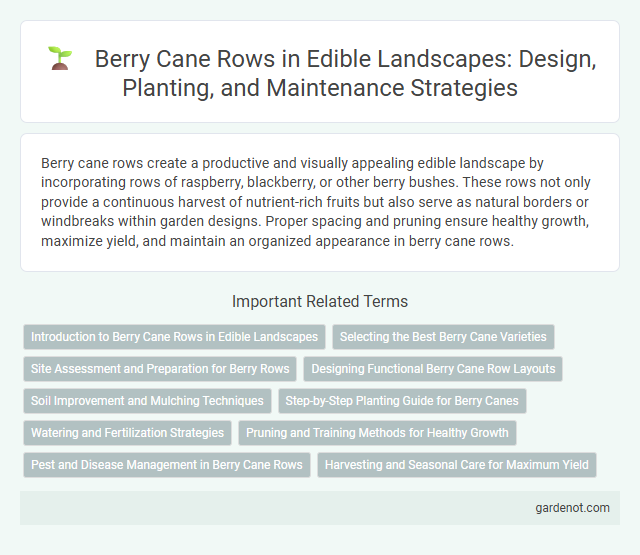Berry cane rows create a productive and visually appealing edible landscape by incorporating rows of raspberry, blackberry, or other berry bushes. These rows not only provide a continuous harvest of nutrient-rich fruits but also serve as natural borders or windbreaks within garden designs. Proper spacing and pruning ensure healthy growth, maximize yield, and maintain an organized appearance in berry cane rows.
Introduction to Berry Cane Rows in Edible Landscapes
Berry cane rows create productive and visually appealing edible landscapes by combining rows of berry-producing plants such as raspberries, blackberries, and blueberries. These plants thrive in well-drained soil with ample sunlight, offering seasonal harvests rich in antioxidants and vitamins. Incorporating berry cane rows enhances biodiversity, supports pollinators, and provides sustainable food sources within garden designs.
Selecting the Best Berry Cane Varieties
Selecting the best berry cane varieties for an edible landscape depends on flavor profiles, disease resistance, and yield capacity. Popular options include thornless blackberries like 'Triple Crown' and 'Apache' for their sweetness and hardiness, as well as red raspberry varieties such as 'Heritage' known for their continuous production and cold tolerance. Prioritizing site-specific adaptability and pollination requirements enhances fruit quality and overall garden productivity.
Site Assessment and Preparation for Berry Rows
Site assessment for berry cane rows involves analyzing soil pH, drainage, and sunlight exposure to ensure optimal growth conditions. Preparing the site includes clearing weeds, enriching soil with organic matter, and creating well-drained raised beds to prevent waterlogging. Proper spacing and alignment of rows enhance air circulation and sunlight penetration, which are critical for healthy berry cane development.
Designing Functional Berry Cane Row Layouts
Designing functional berry cane row layouts requires strategic spacing to maximize sunlight exposure and air circulation, which promotes healthy growth and fruit production. Incorporating drip irrigation systems and mulch pathways enhances moisture retention and weed control while facilitating efficient maintenance. Aligning rows with natural land contours reduces soil erosion and optimizes nutrient distribution for robust berry cane development.
Soil Improvement and Mulching Techniques
Berry cane rows benefit significantly from soil improvement practices such as incorporating organic compost and well-aged mulch to enhance soil fertility and structure. Mulching techniques using straw or wood chips conserve moisture, regulate soil temperature, and suppress weed growth, promoting healthier root development. These integrated soil and mulching strategies increase berry yield and plant resilience in edible landscapes.
Step-by-Step Planting Guide for Berry Canes
Prepare the soil by removing weeds and loosening the ground to a depth of 12 inches, ensuring optimal drainage for berry cane roots. Space cane plants 3 to 4 feet apart in rows that are 8 to 10 feet wide to allow adequate sunlight exposure and air circulation. Water deeply after planting and mulch to retain moisture and suppress weeds, promoting healthy growth and fruit production.
Watering and Fertilization Strategies
Berry cane rows thrive with consistent watering that maintains evenly moist soil, avoiding both waterlogging and drought stress to promote healthy root and fruit development. Applying balanced fertilizers rich in nitrogen, phosphorus, and potassium during early growth stages enhances cane vigor and berry yield, while periodic soil tests guide precision nutrient management. Drip irrigation combined with organic mulch improves water efficiency and nutrient retention, supporting sustainable edible landscape practices.
Pruning and Training Methods for Healthy Growth
Berry cane rows thrive with proper pruning techniques that remove old, diseased, or weak canes to promote vigorous new growth and increase fruit production. Training methods like trellising support the canes, improving air circulation and sunlight exposure, which reduces disease risk and enhances berry quality. Regular pruning during dormancy and tying canes to a sturdy framework ensures a productive and healthy edible landscape.
Pest and Disease Management in Berry Cane Rows
Effective pest and disease management in berry cane rows involves regular monitoring for common threats such as aphids, spider mites, and cane blight. Implementing integrated pest management (IPM) strategies, including biological controls and targeted fungicide applications, minimizes chemical exposure and promotes plant health. Maintaining proper spacing and pruning improves air circulation, reducing the risk of fungal infections and enhancing overall berry yield.
Harvesting and Seasonal Care for Maximum Yield
Harvest berry cane rows during late summer to early fall when fruits are fully ripe and easily detached from the canes for optimal sweetness. Regularly prune dead or diseased canes in late winter to promote airflow and sunlight penetration, enhancing fruit quality and reducing pest infestations. Mulching around the base conserves soil moisture and suppresses weeds, while consistent watering during dry spells supports vigorous growth and maximum yield.
Berry cane row Infographic

 gardenot.com
gardenot.com